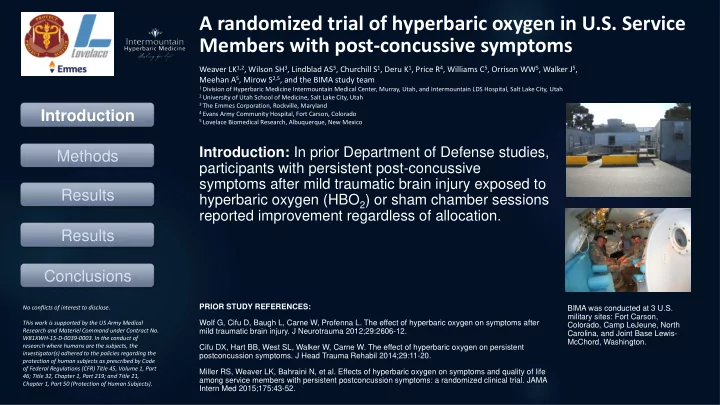

A randomized trial of hyperbaric oxygen in U.S. Service Members with post-concussive symptoms Weaver LK 1,2 , Wilson SH 3 , Lindblad AS 3 , Churchill S 1 , Deru K 1 , Price R 4 , Williams C 5 , Orrison WW 5 , Walker J 5 , Meehan A 5 , Mirow S 2,5 , and the BIMA study team 1 Division of Hyperbaric Medicine Intermountain Medical Center, Murray, Utah, and Intermountain LDS Hospital, Salt Lake City, Utah 2 University of Utah School of Medicine, Salt Lake City, Utah 3 The Emmes Corporation, Rockville, Maryland Introduction 4 Evans Army Community Hospital, Fort Carson, Colorado 5 Lovelace Biomedical Research, Albuquerque, New Mexico Introduction: In prior Department of Defense studies, Methods participants with persistent post-concussive symptoms after mild traumatic brain injury exposed to Results hyperbaric oxygen (HBO 2 ) or sham chamber sessions reported improvement regardless of allocation. Results Conclusions PRIOR STUDY REFERENCES: No conflicts of interest to disclose. BIMA was conducted at 3 U.S. military sites: Fort Carson, Wolf G, Cifu D, Baugh L, Carne W, Profenna L. The effect of hyperbaric oxygen on symptoms after This work is supported by the US Army Medical Colorado, Camp LeJeune, North Research and Materiel Command under Contract No. mild traumatic brain injury. J Neurotrauma 2012;29:2606-12. Carolina, and Joint Base Lewis- W81XWH-15-D-0039-0003. In the conduct of McChord, Washington. research where humans are the subjects, the Cifu DX, Hart BB, West SL, Walker W, Carne W. The effect of hyperbaric oxygen on persistent investigator(s) adhered to the policies regarding the postconcussion symptoms. J Head Trauma Rehabil 2014;29:11-20. protection of human subjects as prescribed by Code of Federal Regulations (CFR) Title 45, Volume 1, Part Miller RS, Weaver LK, Bahraini N, et al. Effects of hyperbaric oxygen on symptoms and quality of life 46; Title 32, Chapter 1, Part 219; and Title 21, among service members with persistent postconcussion symptoms: a randomized clinical trial. JAMA Chapter 1, Part 50 (Protection of Human Subjects). Intern Med 2015;175:43-52.
A randomized trial of hyperbaric oxygen in U.S. Service Members with post-concussive symptoms Methods: In this exploratory, double-blind, sham-controlled trial of HBO 2 Introduction for military personnel with persistent post-concussive symptoms, 71 randomized participants received forty 60-minute HBO 2 (1.5 atmospheres Methods absolute, n=36) or sham chamber sessions (air, 1.2 atmospheres absolute, n=35). At baseline, 35 participants (49%) met post-traumatic stress disorder (PTSD) criteria. Results Outcomes included post- concussive symptoms, quality Results of life, neuropsychological, neurological, EEG, sleep, Conclusions audiology/vestibular, autonomic, visual, brain imaging, and laboratory No conflicts of interest to disclose. testing, at baseline, 13 weeks This work is supported by the US Army Medical Research and Materiel Command under Contract No. W81XWH-15-D-0039-0003. In the conduct of (shortly post-intervention), and research where humans are the subjects, the investigator(s) adhered to the policies regarding the 6 months, plus 12-month protection of human subjects as prescribed by Code of Federal Regulations (CFR) Title 45, Volume 1, Part symptom questionnaires. 46; Title 32, Chapter 1, Part 219; and Title 21, Chapter 1, Part 50 (Protection of Human Subjects).
A randomized trial of hyperbaric oxygen in U.S. Service Members with post-concussive symptoms Key findings: Introduction • By the Neurobehavioral Symptom Inventory, the HBO 2 group had improved 13-week scores compared to sham (HBO 2 mean change -3.6 Methods points, sham mean change +3.9 points, p=0.03). • In participants with PTSD, change with HBO 2 was more pronounced (-8.6 Results points vs. +4.8 points with sham, p=0.02). • Rivermead Post-Concussion Symptom Questionnaire RPQ-3 improved Results with HBO 2 compared to sham (mean change difference -1.5, p=0.01). The PTSD Checklist-Civilian version scores also improved in the HBO 2 Conclusions group, and more so in the subgroup with PTSD. • Improvements regressed at 6 and 12 months. No conflicts of interest to disclose. • HBO 2 improved some cognitive processing speed and sleep measures. This work is supported by the US Army Medical Research and Materiel Command under Contract No. W81XWH-15-D-0039-0003. In the conduct of research where humans are the subjects, the investigator(s) adhered to the policies regarding the protection of human subjects as prescribed by Code of Federal Regulations (CFR) Title 45, Volume 1, Part 46; Title 32, Chapter 1, Part 219; and Title 21, Chapter 1, Part 50 (Protection of Human Subjects).
A randomized trial of hyperbaric oxygen in U.S. Service Members with post-concussive symptoms Key findings (continued): Introduction • Participants with PTSD receiving HBO 2 had improved sensory organization test scores and reduced vestibular complaints at 13 weeks. Methods • Participants without PTSD had improved anger control with HBO 2 . Results • Most measures independent of patient reports did not change over time or did not change in a way that consistently favored one intervention over another. Results Conclusions Conclusions: By 13 weeks, HBO 2 improved post-concussive and PTSD symptoms, cognitive processing speed, sleep quality, and vestibular symptoms, most dramatically in those with PTSD. However, most changes No conflicts of interest to disclose. did not persist to 6-12 months. For military personnel, additional HBO 2 This work is supported by the US Army Medical Research and Materiel Command under Contract No. studies are warranted. W81XWH-15-D-0039-0003. In the conduct of research where humans are the subjects, the investigator(s) adhered to the policies regarding the protection of human subjects as prescribed by Code of Federal Regulations (CFR) Title 45, Volume 1, Part 46; Title 32, Chapter 1, Part 219; and Title 21, Chapter 1, Part 50 (Protection of Human Subjects).
Recommend
More recommend